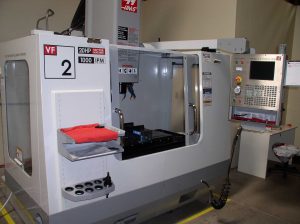Milling is the machining process of using rotary cutters to remove material from a workpiece advancing (or feeding) in a direction at an angle with the axis of the tool. It covers a wide variety of different operations and machines, on scales from small individual parts to large, heavy-duty gang milling operations. It is one of the most commonly used processes in industry and machine shops today for machining parts to precise sizes and shapes.
Milling operates on the principle of rotary motion. A milling cutter is spun about an axis while a workpiece is advanced through it in such a way that the blades of the cutter are able to shave chips of material with each pass. Milling processes are designed such that the cutter makes many individual cuts on the material in a single run; this may be accomplished by using a cutter with many teeth, spinning the cutter at high speed, or advancing the material through the cutter slowly. Most often it is some combination of the three. The speed at which the piece advances through the cutter is called feed rate, or just feed; it is most often measured in length of material per full revolution of the cutter.
As material passes through the cutting area of a milling machine, the blades of the cutter take swarfs of material at regular intervals. This non-continuous cutting operation means that no surface cut by a milling machine will ever be completely smooth; at a very close level (microscopic for very fine feed rates), it will always contain regular ridges. These ridges are known as revolution marks, because rather than being caused by the individual teeth of the cutter, they are caused by irregularities present in the cutter and milling machine; these irregularities amount to the cutter being at effectively different heights above the workpiece at each point in its rotation. The height and occurrence of these ridges can be calculated from the diameter of the cutter and the feed. These revolution ridges create the roughness associated with surface finish.

